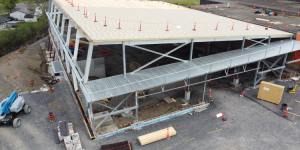Over five years a Kelowna contractor spent $300,000 to invent a system that prevents birds from drilling holes into buildings. Using his 15 years of experience as a stucco contractor, Keith Eisenkrein took his new technique and launched EIFS (exterior insulation and finishing system) Armour. His patent-pending, licensed product has already been applied to almost 200 structures, mostly in B.C.’s Okanagan, where the Northern Flicker and other woodpecker species have been "beaking" havoc.
"Those birds are like flying jackhammers," said Eisenkrein, who’s become somewhat of a bird expert.
The woodpeckers have created a multi-million dollar problem in Kelowna alone, where about 40 per cent of the buildings are stucco.
Because of the work and money he put into EIFS Armour, Eisenkrein, who also has masonry experience, didn’t want to reveal many details about his product, which comes with a lifetime warranty.
"Ours is really tough to copy without us guiding the process," he said. "To get the idea from my head to a mock-up, I make at least a dozen prototypes."
Other products and solutions exist to combat bird problems. Eisenkrein’s system uses a layer of steel mesh that is anchored over the panel or entire moulding, not just the hole. The mesh is recovered with a cement-stucco coating followed by a final layer of an acrylic topcoat that matches the building’s exterior colour.
"When birds peck at it, it doesn’t sound like a tree," he said.
That’s unlike when birds begin tapping on a structure built using EIFS because the Styrofoam, with a coating on top, sounds like a hollow tree to the bird. The woodpecker is able to tap past the layers, right into the substrate and create a three- to four-inch hole.
Smaller birds such as starlings take up residence in the holes, build a nest and lay eggs.
Then the woodpeckers swoop in and raid the nest, Eisenkrein said. Spring is when activity peaks.
One of EIFS Armour’s biggest projects has been remediation of the 151-unit Centuria Urban Village in Kelowna. Owners at the strata building are spending $260,000 to fix approximately 300 holes in the eight-year-old condo.
Another $195,000 is being spent to repair dozens of holes at the Centuria’s ground level commercial premises where nine businesses operate.
Five years ago, when Eisenkrein was testing his prototypes he repaired holes at two locations at the Centuria.
Since the fix, the repaired panels have remained hole-free.
"The proof was in the pudding," said Kris Christiansen, Centuria’s strata president.
EIFS Armour began fixing the Centuria’s 300 punctures in May.
Now when the woodpeckers begin tapping into Centuria it doesn’t sound like a hollow tree so the birds have moved onto other buildings that haven’t been "armoured," he said.
Damage to buildings can go beyond open nests. The holes create a fire hazard by making a building more combustible and water and other pests have ready portals. And then there’s the poop deck.
"You could clean your deck Monday morning and by Wednesday it was dirty again. There comes a point where you don’t want to use your deck," said Christiansen, a building contractor.
Because most of the holes were half-way up the 17-storey building, Eisenkrein spent $40,000 per month to rent a Genie SX-180 boom lift, one of only four in Canada, he said, that weighs almost 24,500 kilograms and can reach 186 feet in under five minutes. Two of his three-to-four man crew can be in the boom, but you won’t find the owner rising high above Kelowna.
"I’m scared to go in it," he said.
The inspiration for Eisenkrein’s "gamble" was an encounter several years ago with the owner of the Playa Del Sol Resort in Kelowna, where $400,000 was spent over seven years to fix holes in the 75,000 square feet of stucco buildings.
Now, as word of EIFS Armour’s success spreads, Eisenkrein has been fielding calls from across Canada and the U.S.
Hot spots for woodpecker damage seem to be in B.C., Alberta, Colorado and several Eastern U.S. states. Eisenkrein, 45, is in the process of selling licensing rights in Atlantic City, N.J., Edmonton and Lethbridge.
"Now I’m recouping the money I invested," he said.
Eisenkrein has hired a lawyer to assist with licensing and his pending patent.
"People are coming to us knowing we can fix it. This feels good, doing something that matters," he said.










Recent Comments
comments for this post are closed